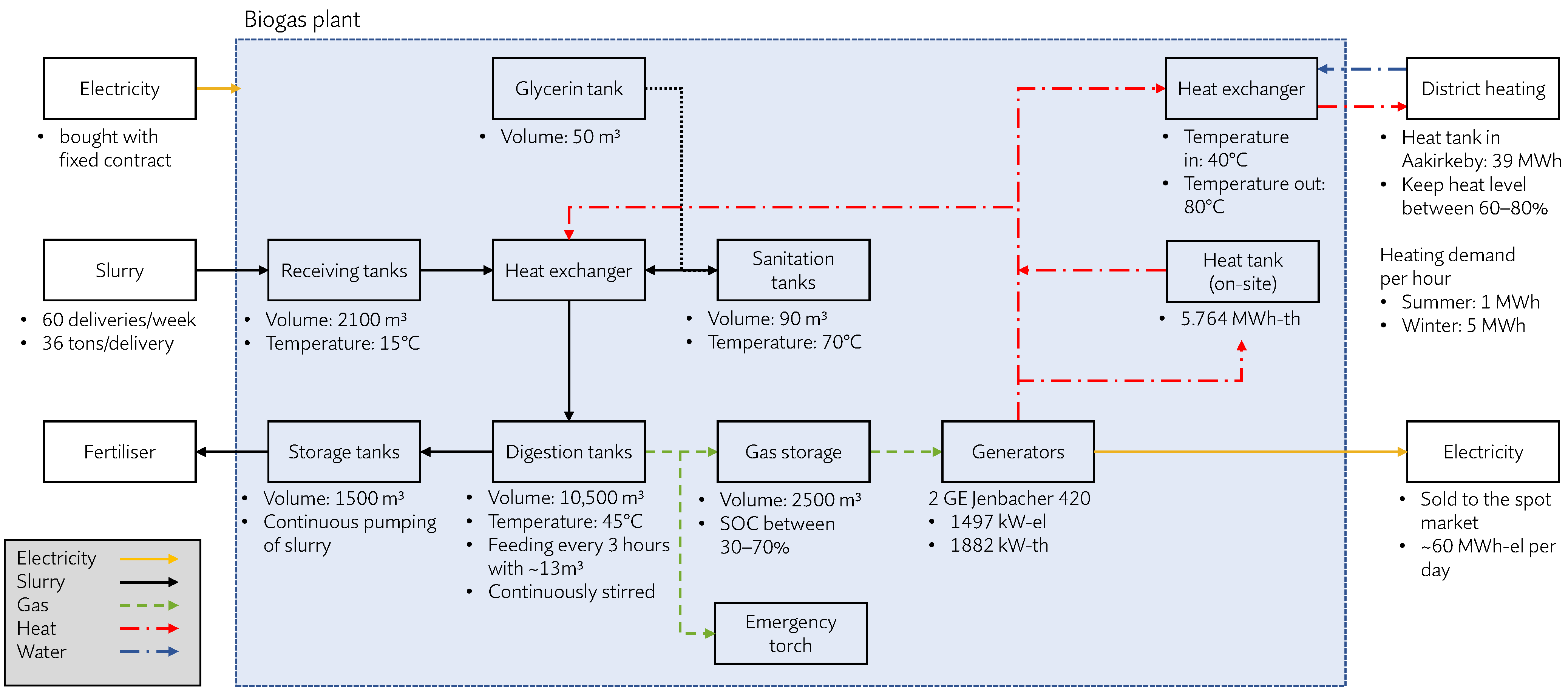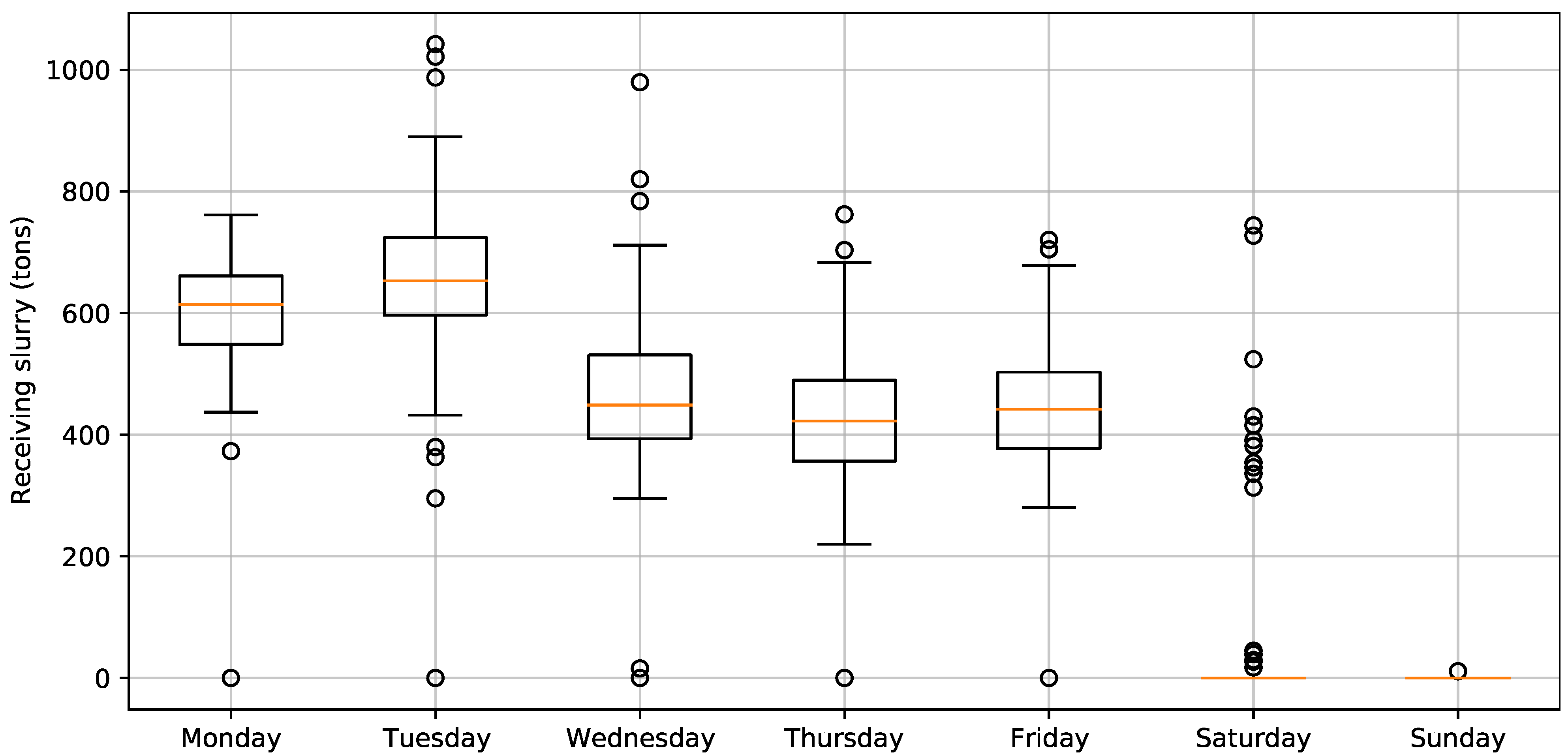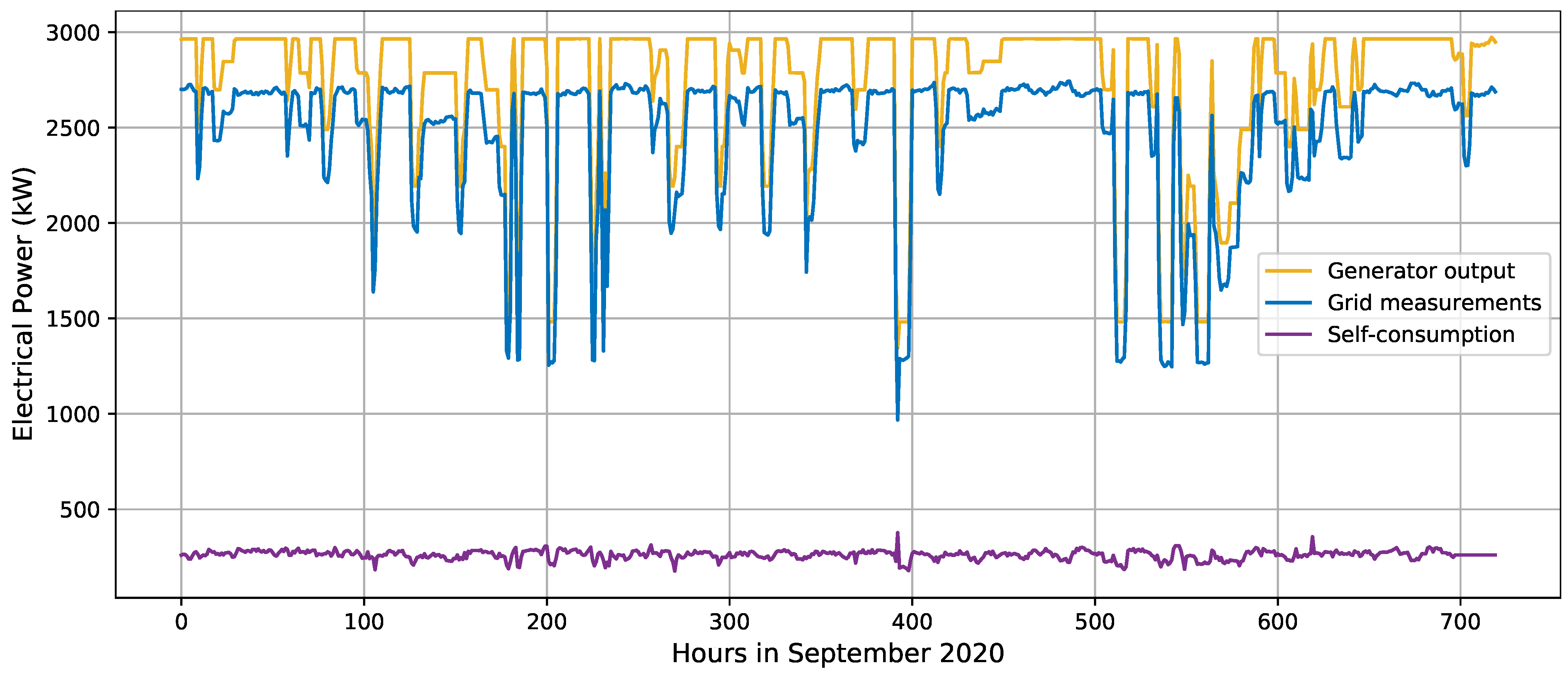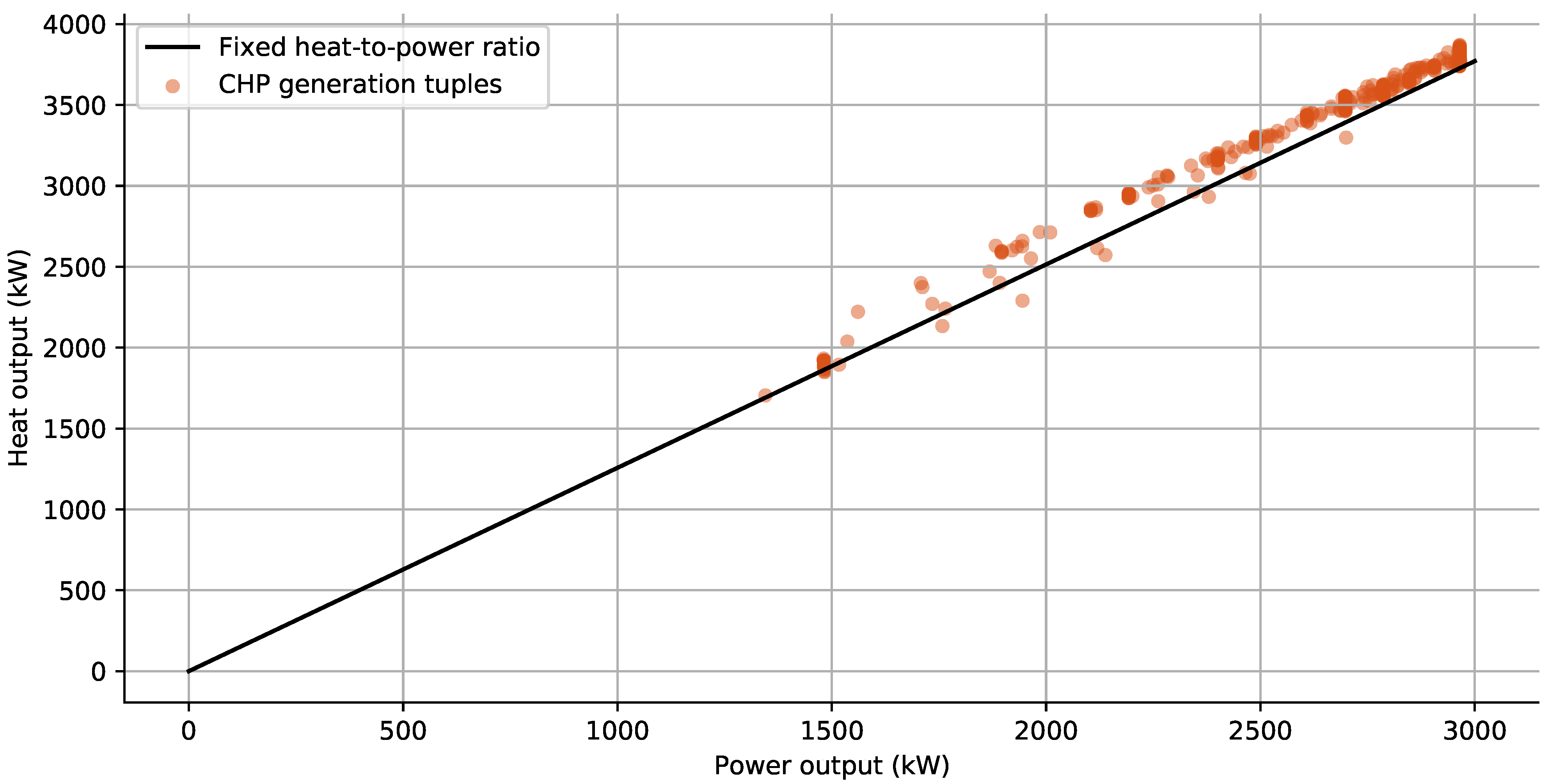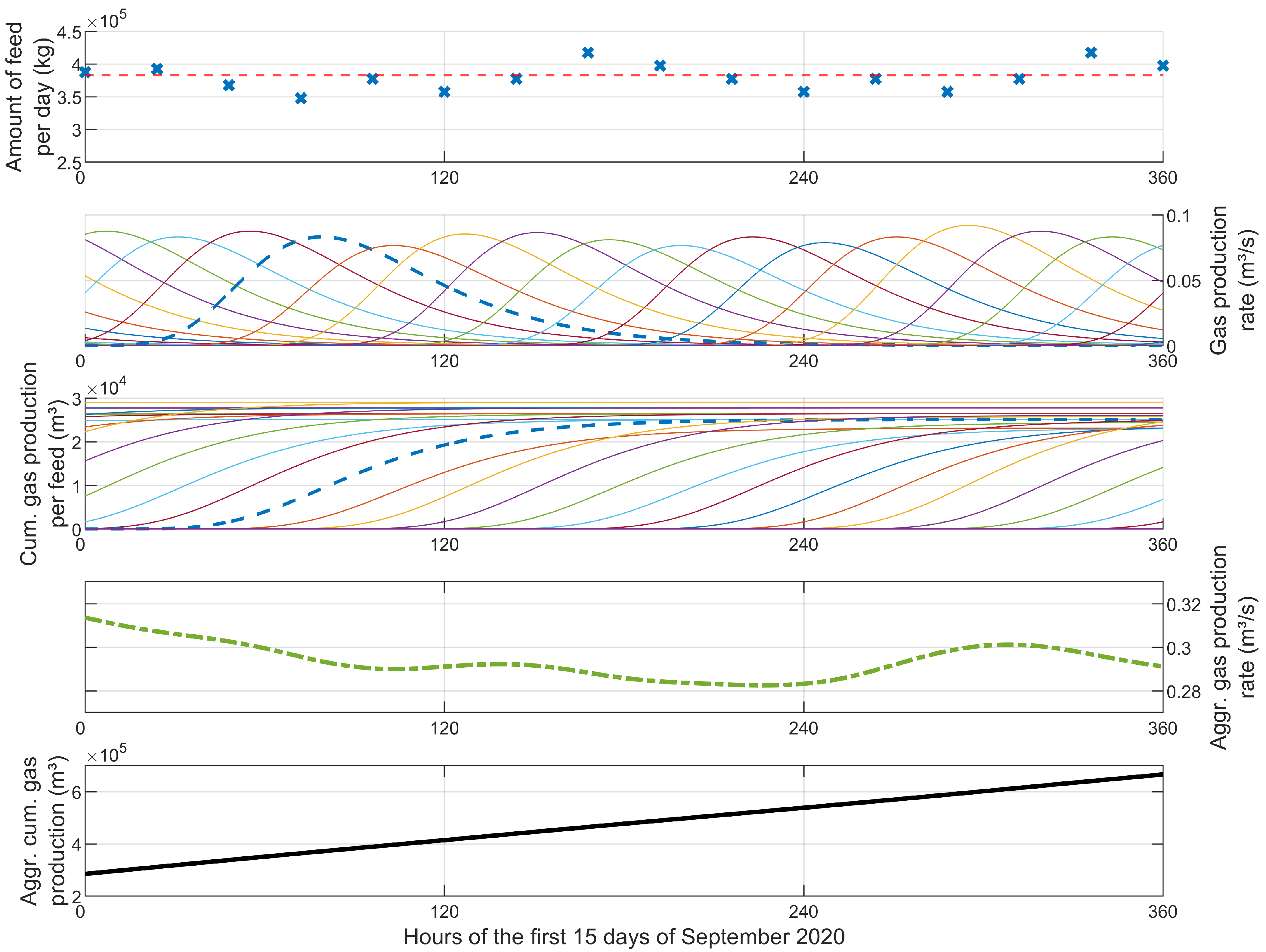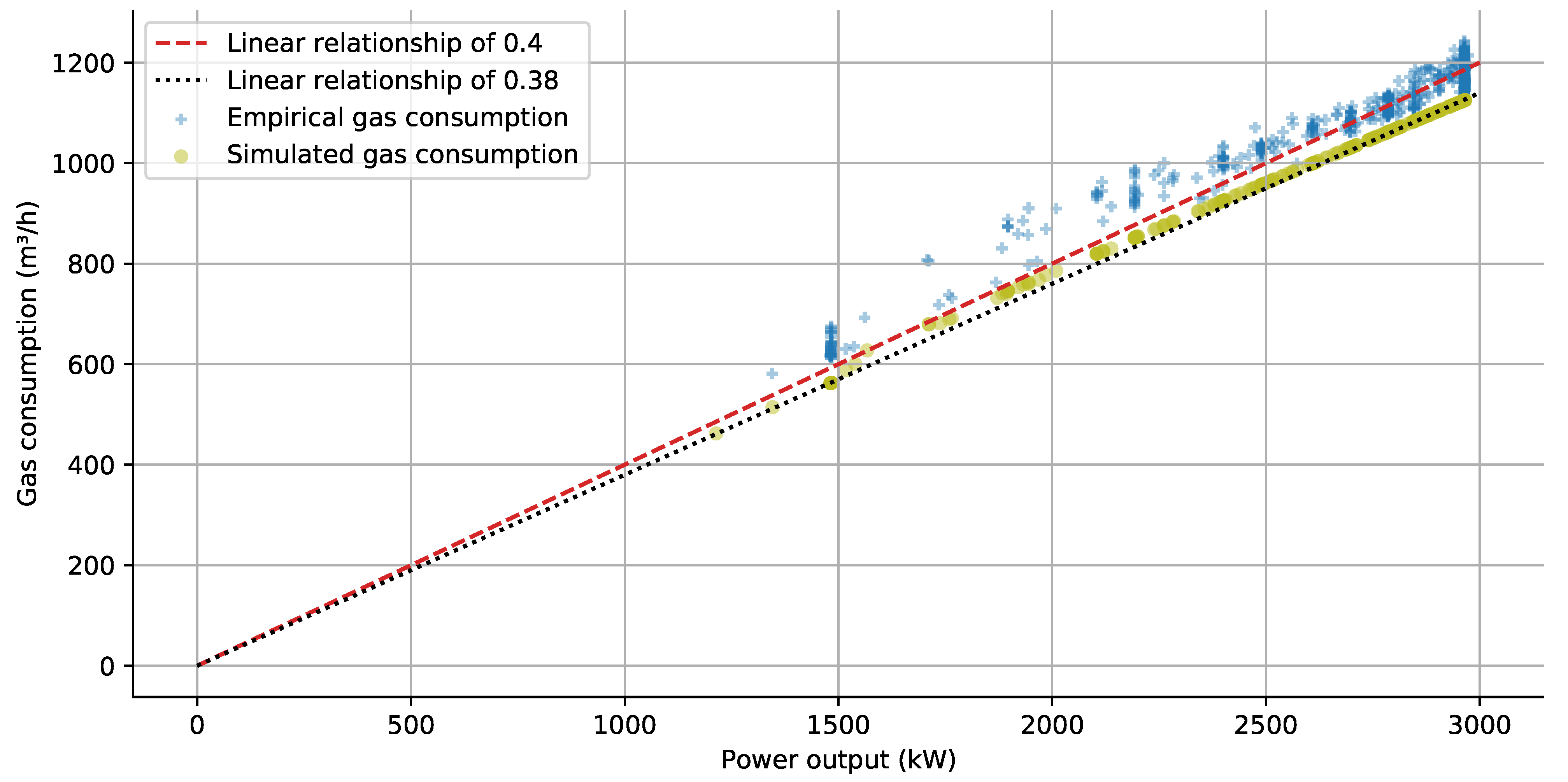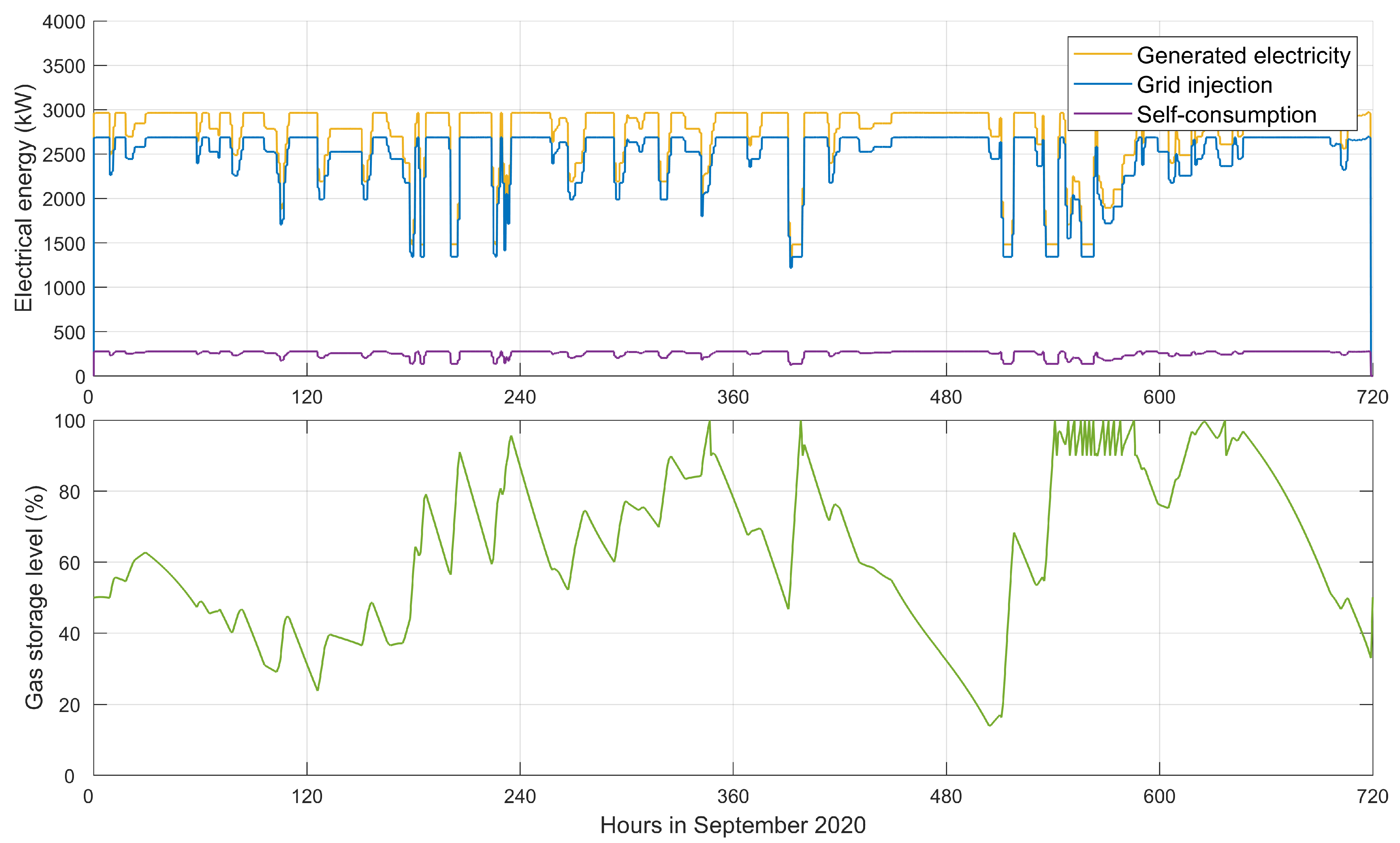1. Introduction
In future power systems, the high shares of renewable energy sources such as wind and solar photovoltaics (PV) challenge grid operations with intermittent and non-dispatchable electricity generation. The power injections of these sources into the grid are only partly controllable as their generation depends on local weather conditions. In addition, they do not supply the system with extensive flexibility to align the generation with the consumption side, making real-time matching more difficult. Together with hydropower plants as well as (battery) storage systems, biogas plants running on organic waste depict one central element of reliable future low-carbon multi-energy systems. In their structure as co-generation units, biogas plants contribute significantly to the further interconnection of future energy systems by acting as intermediary especially between the electrical and thermal domain [
1,
2]. Due to a larger focus on hydrogen as an important and promising energy carrier for low-carbon industry and mobility sectors [
3], biogas plants also represent a compelling site choice for the investment into electrolysis and synthetic gas upgrading facilities for the following reasons: (i) The generated biogas is a source of carbon-dioxide which can be used in the methanization process for producing synthetic natural gas (SNG), mainly composed of methane; (ii) the generated SNG can be stored directly on-site and either burned for co-generation of heat and power or easily distributed to other applications; and (iii) they have—in many cases—already connections to the district heating networks (DHNs), simplifying the reutilization of excess heat and thereby increasing the energy efficiency of the conversion processes.
Biogas plants may support the transformation towards sustainable and renewable-based energy systems. They can provide grid balancing services to supplement the volatile generation from renewable energy sources, while providing electrical and thermal energy vectors [
4]. From an operational point of view, Dotzauer et al. [
5] investigated performance indicators for flexible demand-driven biogas production to define the characteristics of the plants’ flexibility. Depending on the time window, the flexibility of biogas plants originate either from the characteristics of the combined heat and power (CHP) units or the gas storage size. Mauky et al. [
6,
7] explored the impact of flexible feeding strategies and substrate types on the flexibility of the biogas plant and the stability of the process. In [
8], they present a model-predictive controller for deriving feeding strategies for demand-driven electricity production. In a full-scale experiment, they show that the control brings high intraday flexibility and process stability with pulse feeding. The optimal operation of CHP units in real-time markets has been further explored by Gu et al. [
9].
In the context of insular power systems, both aforementioned aspects—the controllability and the flexibility on the generation side—are even more crucial as the system structure does not rely on balancing reserves from large interconnected grids. Theuerl et al. [
10] develop a vision of the future role of flexible biogas plants in a bioeconomy. Envisioned in a modular design, biogas plants would contribute with demand-oriented outputs to integrated energy systems. Korberg et al. [
11] analyze the case for biogas and biogas-derived fuels in a 100% renewable energy system in the Danish context. The authors conclude that from an energy efficiency perspective the utilization of raw biogas without many conversion steps is favorable over other biogas-derived fuels for electricity and heat generation. The role of biomethane and electro-fuels will highly depend on the specific application and the potential alternatives, e.g., the direct electrification in the transportation sector. The H2020-funded Insulae project investigates how the controllability and flexibility from biogas plants can be made available for renewable-dominated insular systems [
12]. It is envisioned to demonstrate the functioning of a multi-domain virtual power plant consisting of different renewable energy sources at the substation of Aakirkeby on Bornholm, as one of the three lighthouse island within this demonstration project. The Danish island aims to be self-sufficient with CO
2 neutral energy production by 2025, to treat all waste as resources by 2032 and become a zero-emission society by 2035 [
13]. For this ambitious decarbonization strategy, a biogas plant represents a central element being able to process organic waste for energy co-generation, and hence increasing the energy efficiency in a bio-based circular economy [
14,
15]. In the examined multi-domain virtual power plant, the biogas plant depicts among other (rather) inflexible resources the central role for providing a controllable energy output. However, a biogas plant is depending on its rigid biochemical processes for producing biogas. The populations of microbial bacteria in the digestion tanks favor predominantly a steady feeding schedule. Moreover, the time constants for the biogas production (hours to days) are by magnitudes higher than for following short-term energy requests (seconds to minutes). The intermediate gas storage might relieve the temporal tension between the two processes. In this regard, it is imperative to model a biogas plant as a whole considering both the anaerobic digestion processes as well as the gas storage dynamics and the combined heat and power generation. The model may hence be combined with other resources for estimating the flexibility of functioning integrated energy systems.
This paper extends the analysis presented in [
16] by providing in-depth information on the internal processes of the Bioenergi biogas plant on Bornholm as well as a detailed validation of the subsequent processes with high-resolution empirical data. Moreover, the paper critically reviews the influence of modeling assumptions and gives an outlook on the energy potentials for biogas upgrading for the investigated site. Thus, the contributions of this paper to the literature can be summarized as follows:
Empirical details are described for the Bioenergi biogas plant on the island of Bornholm at the substation of Aakirkeby. The functioning and characteristics of the plant with all associated processes are outlined in detail.
The paper develops a biogas plant model that has been implemented in the MATLAB&Simulink environment and validates the simulation results against empirical data for the month of September 2020.
The opportunities for an upgrading facility at the site are calculated from an energy perspective in order to estimate potential enhancements for the specific plant.
The remainder of the paper is structured as follows.
Section 2 details the internal processes of Bornholms’s Bioenergi biogas plant and gives insights on numerical specifics.
Section 3 provides an extensive description of the developed mathematical model that considers the anaerobic digestion processes by first-order kinetics as well as the gas storage and CHP generation.
Section 4 validates the simulation results against real measurements from the plant.
Section 5 discusses the main limitations of the model and their impact on the modeling results as well as assesses the biogas upgrading potentials of the plant, while
Section 6 concludes the paper with further research prospects.
2. Empirical Details of the Bioenergi Biogas Plant on Bornholm
Bornholms Bioenergi co-generation biogas plant represents an important part of the island’s future local integrated energy system as well as a key element for incorporating new biomass fractions for multi-energy services. It is electrically connected on the low-voltage side of a 60/10 kV substation that supplies the township of Aakirkeby and surrounding villages. The biogas plant has a nominal electrical output power of almost 3 MW that is composed of two identical Jenbacher JMS 420 co-generation units running on biogas with 1.497 MWel each. The plant is moreover embedded in the local DHN with a nominal thermal output power of 3.776 MWth supplying the townships of Aakirkeby, Lobbæk, Nylars and Vestermarie. During summer, the thermal demand in the DHN is met by the biogas plant alone, while in winter, designated heating plants running on wood chips and oil are used to fulfill the heating requirements.
2.1. Description of the Biogas Plant’s Processes
Biogas is a combustible composition of different gases (mainly methane—CH
4—to approx. 55–70% and carbon dioxide—CO
2—to approx. 30–45%), and it is generated from the microbial decomposition of organic constituents. The exact composition of the gases in biogas is a function of the substrates used in the digestion procedure. In general, a biogas plant comprises different tanks for storing, treating and digesting the organic waste, all connected by pipes for the respective volume flows between the biogas production steps. Subsequent to the biogas generation procedure, biogas plants often have at command one or more CHP units to co-generate electricity and heat.
Figure 1 illustrates the procedures of the Bioenergi biogas plant on Bornholm in a block diagram with further information on each block. The following subsections successively describe the different parts of the Bioenergi biogas plant.
2.2. Feeding Management
The biogas production process starts with the delivery of slurry from local farmers on Bornholm that live in close vicinity to the plant. Deliveries take place around 60 times a week on working days, i.e., around 12 deliveries each day from Monday to Friday, with an average driving distance of 13.8 km. One delivery comprises on average 36 tons of, e.g., animal slurry or slaughterhouse waste. The average price the biogas plant has to pay is around 16 DKK per ton of slurry.
Figure 2 shows the boxplots of the daily received amounts of slurry created from data for a three-year time period between 1 January 2016 to 27 January 2019. By processing local organic waste, the biogas plant contributes to the island’s decarbonization strategy. In the current structure of the plant, the average substrate composition consists of 70.48% cow slurry, 19.82% of pig slurry, 6.17% of slaughterhouse waste, 3.30% of corn and 0.22% of fish waste, with an average percentage of total solids in the feedings of 12–14%. The island of Bornholm has a large feedstock potential both from animal husbandry, household wastes and secondary crops which is currently not fully exploited: from a total estimated amount of 741,425 tons the biogas plant currently has a permission to treat only 120,000 tons per year [
16].
Next, the slurry is pumped from the arriving trucks into the receiving tanks, which are concrete tanks inset into the ground with a total capacity of 2100 m3. In the receiving tanks, the slurry has a temperature of around 15 °C. From there, a certain amount of the slurry is continuously pumped through a heat exchanger in the form of intertwined pipes into three sanitation tanks. In the heat exchanger, the slurry is heated to around 65–70 °C with the help of slurry fed back from the sanitation tanks and excess heat from the generators. The sanitation tanks have a total capacity of 90 m3 and the slurry remains approximately one hour in the sanitation step. In this way, populations of existing bacteria are eliminated that would otherwise interfere with the bacteria population inside the digestion tanks. Moreover, the pre-treatment breaks up the organic components in the slurry such that they are more easily digestible from the bacteria and hence a faster biogas production can be achieved. The heat exchanger not only heats the incoming slurry, but also simultaneously cools the treated slurry from the sanitation tanks which is then fed into the reactor tanks at a temperature of around 45 °C.
On the site, there are three reactor tanks with a total capacity of 10,500 m3, in which the slurry is digested by bacteria under anaerobic conditions. The feeding into the cylindrical reactor tanks takes place every three hours with a volume of approximately 13 m3, accumulating on average to 383 tons per day (in September 2020). The content of the reactor tanks is continuously stirred with a rotor connected to a centrally positioned vertical shaft. From the reactor tanks, a certain amount of slurry is continuously drawn out from the bottom of the tanks and pumped to the storage tanks for the degassed slurry. It is then fetched again by the farmers and used as fertilizers on local fields. The hydraulic retention time, i.e., the average time the material remains in the digestion tank, is 25 days.
2.3. Gas Storage Capacity and Control
The produced biogas is drawn from the top of the reactor tanks and sent through pipes to the gas storage. The gas pipes installed on-site are of the sizes DN200, DN225 and DN280 with respective lengths of 50 m, 20 m and 190 m, leading to a total volume of 550 m3 in the pipes. The on-site gas storage has a capacity of 2500 m3, while additional gas is concentrated in the three digester tanks (3 × 1000 m3). It is aimed at keeping the gas storage level between 40–70% to retain a level of flexibility in both directions, albeit violations to the targeted storage level may occur. An emergency torch is connected to the pipes which is used in case the gas storage reaches its upper limit and the pressure in the pipes becomes too high. The torch then burns excess biogas on the spot.
The gas storage is controlled manually. If more biogas is produced than the amount that can be burned in the gas engines, the amount of infeed is lowered. Vice versa, when the gas storage level is low, the amount of infeed is increased or the generator output lowered.
2.4. Electrical and Thermal Co-Generation of the Plant
Two generators are fed with biogas from the gas storage. The generators get electrical setpoints based on the amount of biogas produced in the process. All produced electricity is sold to the island’s energy system based on a subsidized feed-in tariff of approx. 111 € per MWh supplemented by a price surcharge of approx. 35 € per MWh. For comparison, the mean spot price in the bidding area DK2 for the year 2020 settled at 28.31 €/MWh. The produced electricity can be sold at a higher price than the one the biogas plant must pay for procuring electricity, so the internal electricity consumption for the pumps and the stirring is financially decoupled from the own production. Heat is produced as a byproduct of the electricity generation. Some of the heat is used internally to heat the slurry in the heat exchanger. Another part of the heat is stored in a local water heat tank with a storage capacity of approximately 6 MWh. The biogas plant also has a connection to the local district heating system. In summer, the hourly heating demand is around 1 MWh, while in winter around 5 MWh. Through another heat exchanger the incoming water temperature of the district heating is increased from around 40 °C to at least 80 °C and sent back to the district heating storage tank in Aakirkeby that has a thermal capacity of 60 MWh.
The biogas plant’s operations are energy-intensive.
Figure 3 plots the measured electrical output of the generators together with measurements at the grid side and the derived electrical self-consumption of the plant in an hourly resolution for the month of September 2020. The biogas plant complex is the only consumer at this grid measurement. The figure thus exhibits that a close-to-constant electrical power of 260 kW
el is needed for the plant’s electrical operations. This corresponds to a mean electrical self-consumption of the own production of 9.32%. Naegele et al. [
17] and Akbulut [
18] find similar magnitudes for full-scale biogas plants.
From the thermal energy perspective, a constant amount of heat is recirculated from the generators on site. On the one hand, the heat is directed to the heat exchangers heating the slurry that is pumped into the sanitation tanks from around 15 °C to up to 70 °C. On the other, the heat is used for keeping the digestion tanks at the operating temperature of 45 °C. This constant amount of thermal energy corresponds to 500 kWh
th in one hour. Accordingly, around 12 MWh from the generated thermal energy remains on site which amounts to a thermal self-consumption of 14.7% for the month of September. In winter time, more thermal energy has be to recirculated on-site to be able to sustain the processes and heat the premises. For a 289 kW CHP unit, Akbulut [
18] reports values of up to 45% of the own thermal energy generation over one year at an annual average outside temperature of 7.5 °C. In general, smaller biogas plants will face higher shares of self-consumption in relative terms. The thermal losses for smaller digestion tanks are disproportional to the losses for larger tank volumes. In addition, the auxiliary heat demand of the facilities of the plant do not scale linearly to the size of the units.
2.5. Heat-to-Power Ratio of the CHP Units
In an hourly resolution, there is a strong relationship between the generated heat and generated output power of the biogas plant.
Figure 4 plots the hourly co-generation tuples for the month of September 2020 together with the fixed heat-to-power ratio reported in the generators’ datasheet. From the figure, it can be learned that the actual ratio might be slightly higher than reported, meaning that more heat is produced in hourly averages for a given hourly electrical output power. This might relate back to both inefficiencies in the burning process of the biogas as well as synergetic effects resulting in higher thermal output. From an electrical energy perspective, the heat-to-power ratio of the generators may thus be taken as a slight overestimate as more heat is generated at associated power values.
5. Discussion
In general, the presented results suggest that the dynamic behavior of a biogas plant can be reproduced with sufficient accuracy. The model is able to determine the thermal energy output and self-consumption of the plant as well as the biogas production based on daily feeding instances of raw materials. The first part of this section reviews and challenges the assumptions made in constructing this model. The second part is devoted to an analytical discussion of how the biogas plant can come into focus for the production of alternative fuels.
5.1. Limitations of the Modeling Approach
Step by step, it will be assessed how far the simulation results of the model would change when considering (i) different time resolutions of the feeding, (ii) a dynamic substrate composition, (iii) biochemical interactions in continuously stirred digestion tanks and (iv) a pressure–volume dependency in the gas storage. Lastly, required modifications of the model are discussed to apply it to other months or other biogas plants.
5.1.1. Time Resolution of the Feeding
In reality, the Bioenergi biogas plant is fed every three hours for 37 min with a volume flow of 21 m3 per hour. In the model, this has been simplified to daily instantaneous feedings. The model is not structured to take into account the biochemical reactions to the largest extent, since it is rather directed at disclosing the time constants associated with a feed and its associated biogas production. In addition, there is no comprehensive information on the amount of the single feedings. If an equal amount is fed every 24 h, every 8 h or even every three hours, from the pure perspective of the considered dynamics, the overall biogas production will change insignificantly. Hence, a daily feeding results in a good approximation, i.e., a rather constant biogas production, of a feeding schedule every three hours. This is however depending on the amount of the feeding. If the amount of feedings varies significantly in the three hour feeding schedule, e.g., one larger feed followed by a sequence of smaller feedings, then the wave motion of the biogas production will adjust. In the end, the choice of time resolution depends largely on the level of accuracy that is envisioned in the modeling process. Here, the considered dynamics of a daily feeding are accurate enough to fulfill hourly electrical setpoints. If faster dynamics are of interest, it may be necessary to convert to a three-hour feeding schedule. For example, this could apply when using the biogas plant for providing primary frequency control, where the fast frequency dynamics would require quick changes in the power output. For this specific type of study, the gas storage modeling assumes a larger importance due to the possibility of the buffering for providing the necessary flexibility required by the frequency control without compromising the feeding process.
5.1.2. Dynamic Substrate Composition
A dynamic adjustment of the substrate composition would increase the precision of the model in matching the real values significantly. However, no exhaustive information regarding the substrates are associated with the feeding amount. Hence, from a modeling perspective, the average value of the substrate composition has to serve as the closest possible representation. By dynamically adjusting the substrate composition of the feedings, the biogas potential as well as the share of VS would change dynamically as well. This would lead to a closer representation of the single biogas production rate associated to each feeding, but for the present biogas plant this information is not available.
5.1.3. Biochemical Reactions in the Digester
In a continuously stirred digestion tank, there are biochemical reactions that have an impact on the biogas productivity of the microbial bacteria population. Biochemical interdependencies are not taken into account in this modeling approach as they would specify a level of detail that is out of scope of this analysis. In the same light, sensitivity of the substrate composition or feeding times on the bacteria population is neglected. It is further assumed that the temperature as well as the acidity level (pH-value) is kept constant at an optimal level for the bacteria throughout the digestion process and that they have no influence on the biogas productivity. The modeling of the anaerobic digestion part hence reduces to a mere dynamic process. For a more in-depth representation of these processes, kinetics models such as presented in by Nopharatana et al. [
25] and Rosen et al. [
26] should be considered. Different modeling approaches of anaerobic digestion have been reviewed by Kythreotou et al. [
27], while Heiker et al. [
28] performed a systematic comparison of modeling approaches of biogas production in the context of energy system and process optimization models. The taken simplifications could, e.g., result in a flawed estimation of the biogas production which would contribute to explain the gas storage level evolution depicted in
Figure 8.
5.1.4. Pressure–Volume Dependency
According to Boyle’s law, the volume of a gas is inversely proportional to the pressure at constant temperature. Hence, the amount of gas that can be stored in, e.g., a gas tank or in pipes, may be increased by enhancing the pressure level. This dependency is not taken into account which has a strong effect on the presented results. In the lower plot of
Figure 8, the evolution of the biogas storage is presented. It can be seen that the biogas storage level hits in multiple occasions the upper bound. It could be speculated that this has not been happening in reality as the targeted range in which the biogas storage is operated is between 40–70%, according to information from the plant. By introducing a pressure–volume dependency, the evolution of the gas storage level will be compressed more towards the mid-range of the storage capacity, and consequently not collide with the storage boundaries.
5.1.5. Generalization of the Model
Due to limited data availability from the plant, the model has been fitted to and validated for the month of September 2020. The proposed modeling approach allows, however, for the application of the presented model to other months, if feeding instances and electricity reference setpoints are adjusted. Although tailored to one specific biogas plant, the model may also represent other biogas plants if the utilized substrates and their associated biogas production parameters (e.g., biogas potential and maximum production rate) as well as the characteristics of the plant (e.g., generator size, tank volumes) are modified.
5.2. Assessment of Biogas Upgrading Opportunities
Biogas plants play a vital role in multi-energy systems since they provide—besides their low-carbon co-generation of electricity and hea—the possibility of upgrading biogas to synthetic natural gas (SNG) [
29]. The generated SNG can hence be injected into the natural gas grid or liquefied for the transportation sector (e.g., heavy-road or maritime transport). Moreover, biogas plants represent a compelling site choice for power-to-gas and methanization facilities as they offer connections to DHNs which increases the energy efficiency of the conversion processes. Within the Insulae project, the role of a biogas plant is investigated as part of a multi-domain virtual power plant. This section analytically reviews the potential for biogas upgrading at the Bioenergi biogas plant on the island of Bornholm from a pure energy perspective. Due to its high efficiency at elevated temperatures and possible utilization of waste heat, the catalytic methanization of biogas via hydrogenation is examined. Based on a Sabatier reaction, biogas is enriched with hydrogen (H
2) for converting its share of carbon dioxide (CO
2) to methane (CH
4). The investigation and comparison of alternative upgrading technologies (e.g., CO
2 removal by physical or biological methods) has not been carried out in this paper and remains for further research. A review of current and prospective biogas upgrading technologies has been performed by Angelidaki et al. [
30].
Following the energy balance presented by the Danish Energy Agency and Energinet [
31] illustrated in
Figure 9, a methanization process via the hydrogenation of biogas requires besides a small share of electricity (0.76% of the input energy in MJ) a larger share of hydrogen (45.88% of the input energy in MJ). The remaining 53.36% of the input energy is stored in the biogas. If it is intended to transform the monthly biogas production of 750,000 m
3 from the plant into SNG, approximately 121 tons of hydrogen and 67 MWh of electricity are needed, following the above stated ratio in terms of energy. The production of 121 tons of hydrogen requires in one month 6655 MWh of electrical energy, assuming an efficiency of 55 kWh/kg H
2 in an electrolysis process [
32,
33]. For one month of 30 days, this would require an electrolyzer of 9.2 MW to be run at nominal power throughout the whole month.
Then, out of 750,000 m3 biogas, a total amount of 815,929 m3 of SNG may be produced. While the total energy that can be retrieved from 750,000 m3 of biogas with an assumed energy content of 6.5 kWh/m3 is 4875 MWh, the upgraded amount of SNG holds an energy content of approximately 8135 MWh, considering 9.97 kWh/m3. The energy content of the biogas corresponds to the energy requirement of the generators running at 95% of nominal power throughout the month. From the produced SNG, only 62.7% could be directly utilized in the generators running at full load. The remaining 37.3% (3034 MWh; 304,349 m3) of the SNG production can be used either for transportation or other energy requirements. It is noteworthy that the gained 3034 MWh stored in the SNG in relation to the additional 6655 MWh needed for the electrolysis process result in an efficiency of 45.59% for this conversion process. The monthly energy requirement for the electrolysis process is three times higher than the biogas plant’s electrical energy production. To this end, it would be important to couple the electrolysis process with surrounding large-scale renewable energy sources such as wind and PV farms where excess generation in case of grid overloading may be used for hydrogen generation. However, it is unlikely that this will result in a constant 9 MW power flow throughout the month.
6. Conclusions
Biogas plants offer solutions to the challenges that arise from the green energy transformation. They provide dispatchable electricity generation necessary for grid balancing of renewable energy systems, and entail potentials for biogas upgrading and conversion to alternative fuels, e.g., in case of an oversupply of variable renewable energy. This paper gathers empirical insights on the functioning of a biogas plant on the island of Bornholm, Denmark. A simulation model for representing the relevant dynamics of the internal processes of a biogas plant has been developed and validated against historical measurements from the plant. The model considers the transients of the anaerobic digestion based on first-order kinetics, the gas storage, the CHP units, as well as the auxiliary self-consumption of the complex. The simulation results match the historical measurements with high accuracy. Hence, the model may be able to characterize the functioning of the plant also for unknown power requests.
The influence of made assumptions regarding the time resolutions of the feeding, dynamic substrate composition, simplifications of biochemical reactions and neglected pressure–volume dependency on the simulation results has been discussed in detail. With the approximations of the biochemical reactions in the anaerobic digestion, the model does not aim at the highest accuracy in the biogas production process, but it gives an estimate of the relationship between feeding management and biogas production that can be utilized for flexibility provision towards the electrical and thermal networks. Future work will be directed at the enhancement of a virtual power plant in combination with adjacent wind and PV farms where the flexibility of the biogas plant will be exploited for providing grid services. The here presented model can thus be used to develop control strategies for virtual power plants comprising a biogas plant.
Furthermore, the paper discusses the potentials for biogas upgrading via hydrogenation at this specific plant from a pure energy perspective, i.e., neglecting the necessary infrastructure and process dynamics of the conversion. Hence, the amount of hydrogen needed can be estimated and put in relation to the gained energy output of biomethane. From an energy efficiency perspective, it can be concluded that the process is connected to high losses that compromise the viability of the conversion. Further research needs to be conducted to investigate the potentials of alternative fuels that can be derived from biogas for decarbonizing, e.g., the transport or industry sector.
